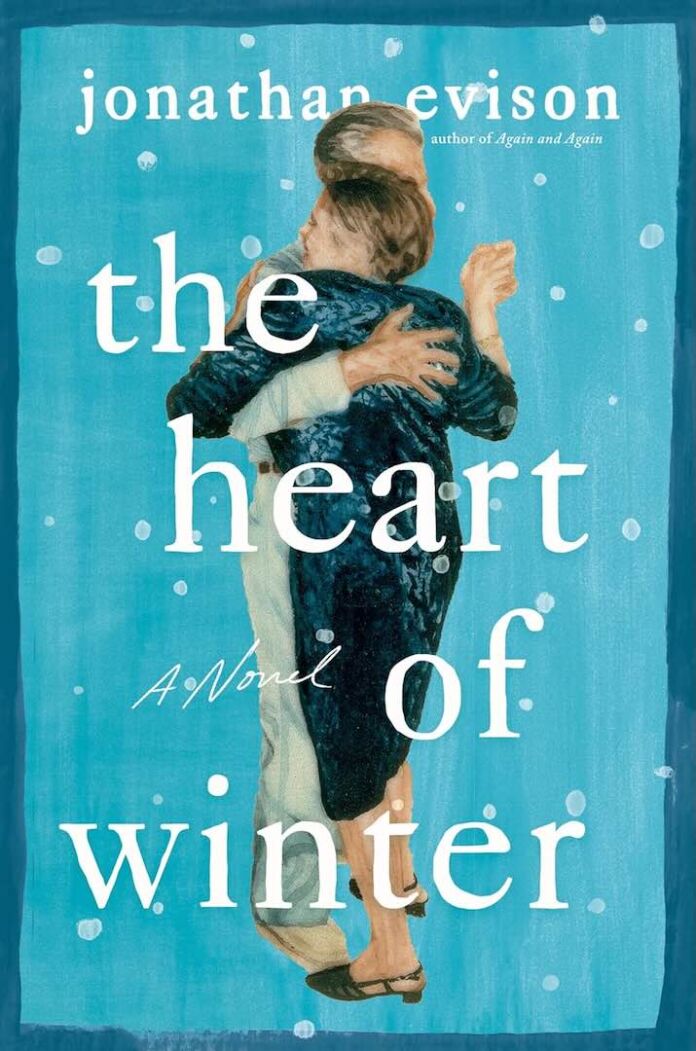In his ninth novel, The Heart of Winter, Jonathan Evison crafts an intimate portrait of a 70-year marriage that feels both expansive in its timespan and wonderfully precise in its attention to life’s small, defining moments. Through the story of Abe and Ruth Winter, Evison explores how love endures not through grand gestures, but through the quiet acts of showing up day after day, year after year.
The Dance of Opposites
At the heart of this novel is an unlikely pairing – Ruth Warneke, a poetry-loving liberal arts student with dreams of Paris, and Abe Winter, a pragmatic business major who finds security in life insurance policies and bow ties. Their initial blind date in 1953 seems destined for failure, yet somehow these opposites begin a dance that will last seven decades.
Evison masterfully weaves between past and present, showing us how young Ruth and Abe become the elderly couple facing their greatest challenge yet – Ruth’s cancer diagnosis and treatment. The narrative structure allows us to see both how much they’ve changed and how their essential natures remain constant: Ruth still yearning for beauty and adventure, Abe still finding comfort in routine and responsibility.
Strengths and Literary Craftsmanship
The novel’s greatest triumph lies in its authentic portrayal of long-term partnership. Evison avoids both saccharine sentimentality and cynical darkness, instead finding truth in the middle ground where most relationships actually exist. The writing shines particularly bright in moments of quiet observation:
“To hold his hand was to be felt, to be tethered to something solid amidst the vast confusion of the universe.”
The author demonstrates remarkable skill in:
- Capturing the rhythms of long-term relationships
- Balancing humor with profound emotional depth
- Creating vivid secondary characters who illuminate the main story
- Depicting aging with dignity and nuance
- Exploring how political and ideological differences affect intimate relationships
Areas for Growth
While predominantly successful, there are moments where the novel’s pacing feels slightly uneven. The early chapters occasionally linger too long on establishment, while some of the later emotional crescendos feel rushed. Additionally, a few of the supporting characters, particularly the Winters’ children, could have been more fully developed.
Notable Themes
The Politics of Partnership
Evison deftly uses Abe and Ruth’s opposing political views (he’s Republican, she’s Democrat) as a metaphor for how marriages survive fundamental differences. Their ability to maintain love despite disagreement speaks to larger questions about unity in divided times.
The Nature of Care
As Ruth faces cancer treatment, the novel explores what it means to care for someone you love, especially when that care challenges your capabilities. Abe’s determination to be Ruth’s caregiver despite his own limitations becomes a powerful testament to love’s ability to transcend physical constraints.
Time’s Passage
The novel’s structure, moving between decades, allows Evison to explore how time changes us while certain essential truths remain. The farm on Bainbridge Island becomes both a constant and a measure of change, its seasonal rhythms marking the passage of years.
Literary Context
Readers familiar with Evison’s previous works (Small World, Lawn Boy, West of Here) will recognize his talent for creating richly detailed worlds and deeply human characters. The Heart of Winter feels like a natural evolution of his storytelling abilities, combining the historical sweep of Small World with the intimate character work of All About Lulu.
The novel sits comfortably alongside other contemporary works exploring long-term relationships, such as Lauren Groff’s Fates and Furies or Jane Smiley’s Some Luck, while maintaining its own distinct voice and perspective.
Critical Assessment
What Works
- Beautiful prose that avoids pretension
- Authentic dialogue that captures both period and personality
- Rich sense of place and time
- Nuanced exploration of aging and illness
- Skillful balance of humor and gravity
What Could Be Stronger
- More development of secondary storylines
- Smoother transitions between time periods
- Deeper exploration of some supporting characters
- More consistent pacing throughout
Final Verdict
The Heart of Winter is a remarkable achievement that reminds us how the greatest love stories aren’t about passion’s first bloom but about its patient cultivation over decades. Through Abe and Ruth’s story, Evison shows us that true romance lies not in grand gestures but in the willingness to weather life’s storms together, to compromise without losing oneself, and to find beauty in routine.
The novel offers readers a moving meditation on marriage, aging, and the nature of lasting love. While not perfect, its flaws are minor compared to its considerable achievements. This is a book that will resonate particularly with readers who appreciate subtle emotional complexity and authentic relationship dynamics.
Recommendation
This novel is highly recommended for:
- Readers who appreciate literary fiction with emotional depth
- Those interested in stories about long-term relationships
- Fans of character-driven narratives
- Anyone seeking insight into how marriages survive fundamental differences
- Readers who enjoy multi-generational family stories
In Conclusion
The Heart of Winter is ultimately a celebration of love’s capacity to endure, adapt, and deepen over time. Through Abe and Ruth’s story, Evison reminds us that the most profound romances aren’t those that burn brightest at first sight, but those that continue to warm us through life’s winters. Despite its few shortcomings, this is a novel that will stay with readers long after they’ve turned the final page, inviting reflection on their own relationships and the nature of lasting love.





